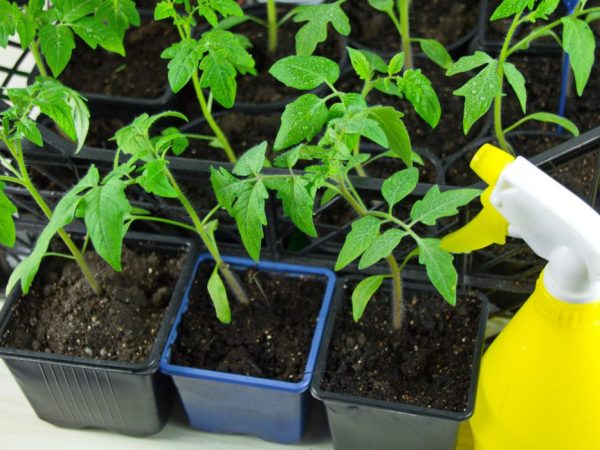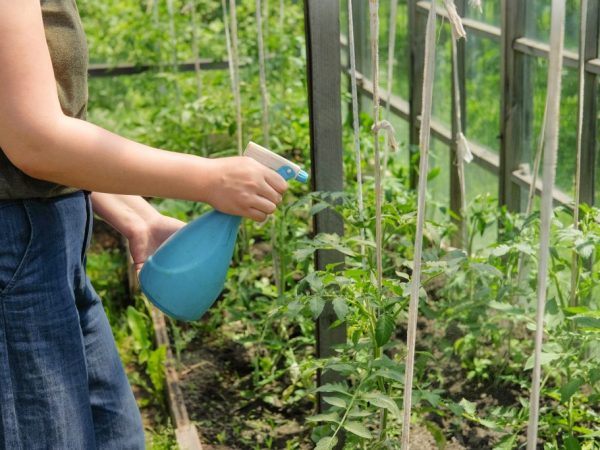Spraying rules for tomatoes
Leaf-dressing is sometimes more efficient and quicker than any root application. How is tomato spraying going and what is it for? We will analyze in detail the important points of the agricultural event.

Spraying rules for tomatoes
Why is it needed
Vegetable crops assimilate substances not only through the underground parts, but also through the foliage. In tomatoes, this ability is highly developed. Plants react painfully to a lack of trace elements, temperature changes. At high humidity, fungi are activated, and in heat, the roots can be burned with chemical dressings.
Even a well-fertilized soil before planting is not able to feed abundantly fruiting tomato bushes until the middle of the season.
Leaf handling is an emergency aid for tomatoes. Fertilizers, stimulants and fungicides enter the cells directly, bypassing the long period of absorption through the soil. The drugs begin to work in the first two hours, and not after 10 days, as it usually happens.
Foliar dressing is effective at any stage of crop development. Weakened seedlings better absorb trace elements and quickly acquire a healthy appearance. You cannot do without spraying on the leaf during the flowering and fruiting periods: plants absorb only the necessary substances and do not accumulate nitrates.
Food
If vegetables develop poorly and have an unhealthy appearance, then we recommend alternating root and foliar applications. While the nutrients get to the underground parts, the tops will quickly absorb only everything they need. The procedures are carried out in cloudy weather or in the evening, when the sun is no longer so hot.
Deficiency signs
The lack of any of the elements is often accompanied by noticeable symptoms. This is especially evident at the stages of the formation of green mass and fruits. Of course, in each case there are exceptions, but all the signs of shortage are systematic.
- Nitrogen. The foliage turns yellow at the edges, after which it falls off. The veins on the underside of the haulm take on a blue-red tint.
- Magnesium. The disadvantage is manifested in the form of a plate wrapped up.
- Phosphorus. The aboveground parts of the plant darken, acquiring a greenish-blue color. The foliage is deformed, the stem becomes brittle, the roots wither.
- Potassium. As with magnesium deficiency, the leaves curl up and turn yellow around the edges.
- Bor. The tops curl up, and the flowers fall off without the formation of ovaries.
- Zinc. Brown gray spots appear on the plant, turning into necrosis. The shape of the plates changes in the same way as with a lack of magnesium.
It is worth remembering that an excess of any of the substances is just as dangerous as a deficiency. nitrogen-containing preparations activate the formation of tops to the detriment of fruits. Tomatoes also have an unpleasant habit of accumulating trace elements in the form of nitrates in their pulp.
Tatiana Orlova (Candidate of Agricultural Sciences):
Iron deficiency (chlorosis) is often confused with nitrogen deficiency. With chlorosis, the leaves also turn yellow.Taking this for a nitrogen deficiency, gardeners begin to intensively give ammonium nitrate or urea. Nitrogen deficiency manifests itself primarily on the lower leaves, i.e. in this case, the leaves of the lower tier turn yellow first, while with iron deficiency, the tops of the plants turn yellow.
The beginning of growth

Spraying will help the development of plants
Nitrogen is the most important component responsible for the absorption of other minerals. With a lack of substance, the plants become pale and thin, the foliage becomes yellow. In advanced cases, the culture sheds the ovaries and gradually dies.
Spraying tomatoes with a urea solution has a beneficial effect on the development of seedlings. To do this, dilute a teaspoon in a bucket of liquid and pour it into a spray bottle. The procedure is carried out after transplanting to a permanent place of growth and before flowering. Remember that the remedy is contraindicated when tying buds and tomatoes.
Phosphorus assists in the formation of roots and promotes better development of shrubs. With a shortage, the plant stops assimilating nitrogen, which negatively affects the immunity and ripening of fruits. All the trace elements that a vegetable crop needs are contained in the nitrophoska preparation. A spoonful of the product is diluted in 10 liters of liquid, after which it is applied along the sheet.
Lovers of organic fertilizers are not advised to use for spraying humus. Vermicompost is more suitable for processing tops than manure or chicken droppings. Of course, it is not so concentrated, but after the procedure, the condition of the plants and soil improves.
Flowering and fruiting
As soon as buds appear on the bushes, you must immediately proceed to the next stage. During this period, funds are needed to improve the quality of pollen and ovaries. Boric acid is often used in the form of micronutrient fertilizer, which:
- provides fruits with nutrition;
- saturates the pulp with sugar;
- protects against pests, diseases.
You should not use Borofosk, which is designed for watering under the root of trees. Acid is more economical than fertilizer and leaves fewer marks on the plant. In 1 liter of hot liquid, one gram of powder is diluted. On average, 10 ml of solution is consumed per bush. Events are held during the period of mass disclosure of flowers.
To improve fruit formation, one of the proven folk remedies is wood ash. To prepare an extract, a glass of substance is poured with boiling water, infused for a day, filtered and added to a bucket of water. The resulting solution is carefully sprayed with tomatoes - leaves and stems. If you add 20 ml of iodine to the recipe, then the ripening of tomatoes will accelerate.
Stimulation
Inside each of the plants there is a specific set of phytohormones that are responsible for growth, flowering or fruit formation. Based on these natural elements, scientists have developed artificial analogues. Biologics in small doses have a beneficial effect on tomatoes. Of course, they will not replace nutritious feeding, but they will help the culture to cope with stressful situations.
Epin
An excellent tool for adapting to unfavorable conditions of detention - sunburn, cold and heat. The advantage of the substance is the absolute non-toxicity for humans and animals, there is no "habit" accumulates in tissues, fruits. For use, it is enough to dilute 10 drops of the drug in a liter jar of water. Since the active elements decompose under ultraviolet light, all work is carried out after sunset.

The procedure is best done in the evening.
"Epin" cannot eliminate the lack of nitrogen, magnesium or potassium, but it will be possible to make the consequences for the plant minimal. Thanks to the stimulant, the planting of seedlings takes place without complications and mass death of seedlings. Do not get carried away with the drug, otherwise the overfed cultures will stop producing natural hormones on their own.
Zircon
An excellent activator of growth, root formation and flowering, increases resistance to such dangerous diseases as late blight and powdery mildew. Unlike Epin, this agent accumulates in tissues, so the dose and number of sprays must be accurately dosed. Three drops of the medicine are added to a liter of lukewarm water, after which the plants are treated.
Due to the fact that important elements are activated by the sun's rays, the procedures are carried out in the morning. "Zircon" is gradually removed from the tomatoes, after which the event can be repeated again. We do not recommend using several hormonal agents at the same time.
Treatment
No matter how much farmers take care of vegetables, one mistake is enough for diseases to appear. Ailments threaten tomatoes starting from seedlings and ending with the ripening period of fruits. Here it is not enough just to water at the root or sprinkle the affected specimens with a chemical. If you notice the signs of a fungus in time, there is a chance to painlessly and quickly get rid of the disease.
HOM (Chlorine Copper Oxide)
The copper-based preparation resembles the popular Bordeaux mixture in characteristics. The concentrated substance covers the leaf and does not allow the causative agent of the disease, which is hiding under the mulch sawdust, to penetrate the plants. Most often used for prevention and treatment:
- late blight;
- brown spot;
- macrosporiosis.
To prevent diseases, dilute 40 g of "HOM" in a bucket of water, mix thoroughly and spray the plants. If you see the first signs of illness, then the number of treatments is increased. Agricultural work is carried out in the morning or in the evening, preferably in cool weather without wind. The drug does not have protection against rain, so the measures are repeated after precipitation. Fungicide is prohibited to use during flowering and fruit formation.
Fitosporin
An excellent remedy for combating fungal diseases. Active elements suppress the reproduction of pathogens of late blight and powdery mildew. In addition to poisons, the composition contains humic acids, which have a beneficial effect on the root system. The main advantage of the drug is its low toxicity, which makes it possible to use it to protect seedlings.
The product can be used to treat plants during flowering and during fruit ripening. The main disadvantage is poor resistance to precipitation. After rain, we recommend to spray again, not forgetting to water the mulching area - around and over the sawdust.
For processing on a sheet in a bucket of liquid, dilute 5 g of "Fitosporin-M", stir thoroughly and pour into a spray bottle. The interval between preventive measures is two weeks. When treating with the drug, the actions are repeated every 10 days until the visible signs get rid of.
Conclusion
To grow healthy vegetables, you need to know what the procedures are and what they are for. Spraying tomatoes regularly with nutrients, stimulants, or medications can help you harvest a bountiful harvest by the end of the season.



